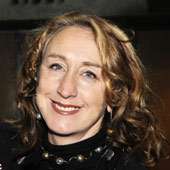Jane Roskams
| Jane Roskams | |
|---|---|
 | |
| Born | Douglas, Isle of Man |
| Residence | Vancouver, BC, Canada |
| Nationality | Manx |
| Alma mater | University College of Swansea, Penn State College of Medicine, Johns Hopkins School of Medicine |
| Scientific career | |
| Fields | Neuroscience |
| Institutions | University of British Columbia |
Angela Jane Roskams is a former neuroscientist at the University of British Columbia (UBC); she was professor in the Brain Research Centre and directed a laboratory of neural regeneration and brain repair, before closing her lab in 2016. Roskams also worked at Johns Hopkins Medical School, where she began research to analyse the mechanisms that drive successful regeneration in the olfactory system and underscore the early loss of brain function in Alzheimer's disease. This led her to research examining the interplay between genetics and the environment in shaping how cells in the nervous system develop and adapt.
Early life and education
Roskams was born and raised on the Isle of Man. She attended the University College of Swansea, from which she graduated with a first class honours degree in biochemistry. A graduate scholarship took her to the United States to study journalism at the University of Idaho for her master's studies.[1] Local reporting resulted in her being awarded a Sigma Delta Chi Award for science journalism. She completed her PhD in neuroscience at Penn State University in 1991.[1]
She completed postdoctoral training fellowships in neuroscience and neuropathology at the National Institutes of Health and Johns Hopkins University School of Medicine, before taking up a professorial position at the University of British Columbia. In addition to her appointments in zoology (Faculty of Science) and psychiatry (Faculty of Medicine), Roskams served as an associate dean.[1]
Research
Roskams has made some contributions to the field of regeneration, focusing on how cells interact during brain development. She researches how neural stem cells and specialized glia in the brain can aid in promoting nervous system development and repair. In 2008, she collaborated with the Allen Institute for Brain Science to bring together a group of experts to produce an annotated gene expression map of the spinal cord,[2] which is now freely used by researchers across the world as a genetic map for discovery.[3] Between 1999 and 2014, the Roskams Lab received more than $1.7 million in funding from the Canadian Institutes of Health Research.[4] Her study of olfactory ensheathing glia has been funded by the Christopher and Dana Reeve Foundation.[5]
In 2011, her lab identified radial glial cells in the periphery of the adult spinal cord.[6] As of 2015, Roskams and the Allen Institute for Brain Science are working on a project known as BigNeuron. This effort joins computer programmers and scientists for "hackathons" in which participants test computer algorithms that could allow for the automated analysis of neurons.[7]
Awards
In 2013, Roskams received the Bernice Grafstein Award for Outstanding Accomplishments in Mentoring from the Society for Neuroscience.[8]
Books and publications
She was the co-editor of Lab Ref, a how-to manual of basic research resources for scientists. That work has been reviewed in publications such as Biochemistry (Moscow) and the Journal of Cell Science.[9][10] She has also been published in Glia,[11] and in Brain Research.[12] Roskams is on the editorial board of BrainFacts.org.[13]
References
- 1 2 3 "Jane Roskams, Ph.D." Allen Institute for Brain Science. Archived from the original on December 22, 2015. Retrieved December 16, 2015.
- ↑ "Allen Institute will give preview of spinal-cord atlas". The Seattle Times. 2008-07-16. Retrieved 2015-12-16.
- ↑ "Gene map charts spinal cord mysteries". MSNBC. 2008-07-17. Retrieved 2012-03-05.
- ↑ "Canadian Research Information System: Roskams". Canadian Institutes of Health Research. Retrieved December 16, 2015.
- ↑ "New tools, new leads". Christopher and Dana Reeve Foundation. September 16, 2011. Retrieved December 16, 2015.
- ↑ "Investigators identify radial glial progenitor cells in adult spinal cord periphery". Genetic Engineering & Biotechnology News. September 16, 2011. Retrieved December 16, 2015.
- ↑ Hamilton, Jon (March 31, 2015). "Hackers teach computers to tell healthy and sick brain cells apart". National Public Radio. Retrieved December 16, 2015.
- ↑ "Society for Neuroscience announces achievement awards". Society for Neuroscience. October 31, 2013. Retrieved December 16, 2015.
- ↑ Wiederschain, G. Ya. (May 2005). "Book Review: Lab Ref. A Handbook of Recipes, Reagents, and Other Reference Tools for Use at the Bench (Roskams, J., and Rodgers, L. (eds.), Humana Press, Humana, 2002, 272 p., $35)". Biochemistry (Moscow). 70 (5): 606. doi:10.1007/s10541-005-0156-6. Retrieved December 16, 2015.
- ↑ O'Sullivan, Justin M. (2003). "Lab Ref: A recipe for every occasion". Journal of Cell Science. 116 (5): 762. doi:10.1242/jcs.00279. Retrieved December 16, 2015.
- ↑ Gilbert, Mary; Smith, Jeff; Roskams, Angela-Jane; Auld, Vanessa J. (2001-05-01). "Neuroligin 3 is a vertebrate gliotactin expressed in the olfactory ensheathing glia, a growth-promoting class of macroglia". Glia. 34 (3): 151–164. doi:10.1002/glia.1050. ISSN 1098-1136. PMID 11329178.
- ↑ Balaban, Carey D.; Roskams, Angela-Jane; Severs, Walter B. "Diazepam attenuation of somatostatin-induced motor disturbances and neurotoxicity". Brain Research. 458 (1): 91–96. doi:10.1016/0006-8993(88)90499-4.
- ↑ "Who we are". BrainFacts.org. Retrieved December 16, 2015.